

Why buy a refractor? For high-quality lunar, planetary, globular cluster, and binary star observing – as well as for surprisingly good views of the brighter Messier, NGC, and IC catalog galaxies and nebulas – many amateur astronomers prefer the crisp, high-contrast, diffraction-free images of a good refractor.
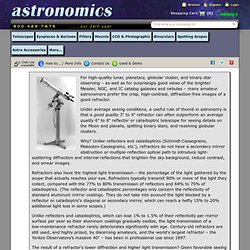
Under average seeing conditions, a useful rule of thumb in astronomy is that a good quality 3" to 4" refractor can often outperform an average quality 6" to 8" reflector or catadioptric telescope for seeing details on the Moon and planets, splitting binary stars, and resolving globular clusters. Why? Unlike reflectors and catadioptrics (Schmidt-Cassegrains, Maksutov-Cassegrains, etc.), refractors do not have a secondary mirror obstruction or multiple-reflection optical path to introduce light-scattering diffraction and internal reflections that brighten the sky background, reduce contrast, and smear images. People Can Draw Energy From Other People The Same Way Plants Do.
A biological research team at Bielefeld University has made a groundbreaking discovery showing that plants can draw an alternative source of energy from other plants.
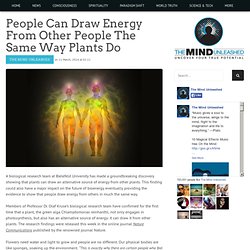
This finding could also have a major impact on the future of bioenergy eventually providing the evidence to show that people draw energy from others in much the same way. Members of Professor Dr. Olaf Kruse’s biological research team have confirmed for the first time that a plant, the green alga Chlamydomonas reinhardtii, not only engages in photosynthesis, but also has an alternative source of energy: it can draw it from other plants. The research findings were released this week in the online journal Nature Communications published by the renowned journal Nature. Flowers need water and light to grow and people are no different. Shinzen Young. Shinzen Young Teaching at Harvard, 2012 Shinzen Young (真善, Shinzen?)
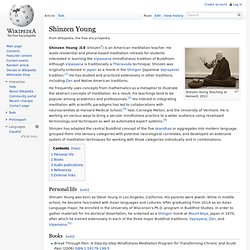
Is an American meditation teacher. He leads residential and phone-based meditation retreats for students interested in learning the Vipassana (mindfulness) tradition of Buddhism. Although Vipassana is traditionally a Theravada technique, Shinzen was originally ordained in Japan as a monk in the Shingon (Japanese Vajrayana) tradition.[1] He has studied and practiced extensively in other traditions, including Zen and Native American traditions. He frequently uses concepts from mathematics as a metaphor to illustrate the abstract concepts of meditation.
Shinzen has adapted the central Buddhist concept of the five skandhas or aggregates into modern language, grouped them into sensory categories with potential neurological correlates, and developed an extensive system of meditation techniques for working with those categories individually and in combinations. Adipogenesis. Adipogenesis is the process of cell differentiation by which preadipocytes become adipocytes.

Adipogenesis has been one of the most intensively studied models of cellular differentiation. Differentiated Adipocyte stained with Oil Red O Introduction[edit] Adipocytes play a vital role in energy homeostasis and process the largest energy reserve as triglycerol in the body of animals.[1] Adipocytes stay in a dynamic state, they start expanding when the energy intake is higher than the expenditure and undergo mobilization when the energy expenditure exceeds the intake.
This process is highly regulated by counter regulatory hormones to which these cells are very sensitive. Nitric oxide. Nitric oxide, or nitrogen oxide,[2] also known as nitrogen monoxide, is a molecule with chemical formula NO.

It is a free radical[3] and is an important intermediate in the chemical industry. Cellular differentiation. Mammalian cell types[edit] Three basic categories of cells make up the mammalian body: germ cells, somatic cells, and stem cells.
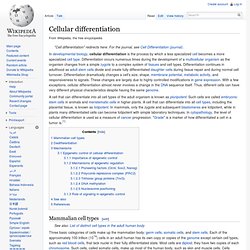
Each of the approximately 100 trillion (1014) cells in an adult human has its own copy or copies of the genome except certain cell types, such as red blood cells, that lack nuclei in their fully differentiated state. Most cells are diploid; they have two copies of each chromosome. Such cells, called somatic cells, make up most of the human body, such as skin and muscle cells. Cells differentiate to specialize for different functions.
Germ line cells are any line of cells that give rise to gametes—eggs and sperm—and thus are continuous through the generations. Pluripotent stem cells undergo further specialization into multipotent progenitor cells that then give rise to functional cells. Franz Kafka. Kafka was born into a middle-class, German-speaking Jewish family in Prague, then part of the Austro-Hungarian Empire.
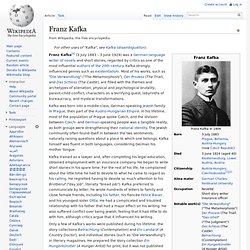
In his lifetime, most of the population of Prague spoke Czech, and the division between Czech- and German-speaking people was a tangible reality, as both groups were strengthening their national identity. The Jewish community often found itself in between the two sentiments, naturally raising questions about a place to which one belongs. Kafka himself was fluent in both languages, considering German his mother tongue. Kafka trained as a lawyer and, after completing his legal education, obtained employment with an insurance company. He began to write short stories in his spare time. Life[edit] Family[edit] Plaque marking the birthplace of Franz Kafka in Prague. The Kafka family had a servant girl living with them in a cramped apartment.
Immanuel Kant. Immanuel Kant (/kænt/;[1] German: [ɪˈmaːnu̯eːl kant]; 22 April 1724 – 12 February 1804) was a German philosopher who is widely considered to be a central figure of modern philosophy.
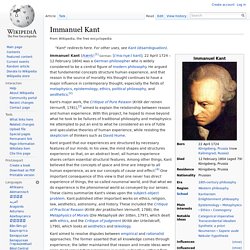
He argued that fundamental concepts structure human experience, and that reason is the source of morality.